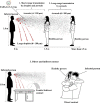Mechanisms controlling the transport and evaporation of human exhaled respiratory droplets containing the severe acute respiratory syndrome coronavirus: a review
- PMID: 36846189
- PMCID: PMC9944801
- DOI: 10.1007/s10311-023-01579-1
Mechanisms controlling the transport and evaporation of human exhaled respiratory droplets containing the severe acute respiratory syndrome coronavirus: a review
Abstract
Transmission of the coronavirus disease 2019 is still ongoing despite mass vaccination, lockdowns, and other drastic measures to control the pandemic. This is due partly to our lack of understanding on the multiphase flow mechanics that control droplet transport and viral transmission dynamics. Various models of droplet evaporation have been reported, yet there is still limited knowledge about the influence of physicochemical parameters on the transport of respiratory droplets carrying the severe acute respiratory syndrome coronavirus 2. Here we review the effects of initial droplet size, environmental conditions, virus mutation, and non-volatile components on droplet evaporation and dispersion, and on virus stability. We present experimental and computational methods to analyze droplet transport, and factors controlling transport and evaporation. Methods include thermal manikins, flow techniques, aerosol-generating techniques, nucleic acid-based assays, antibody-based assays, polymerase chain reaction, loop-mediated isothermal amplification, field-effect transistor-based assay, and discrete and gas-phase modeling. Controlling factors include environmental conditions, turbulence, ventilation, ambient temperature, relative humidity, droplet size distribution, non-volatile components, evaporation and mutation. Current results show that medium-sized droplets, e.g., 50 µm, are sensitive to relative humidity. Medium-sized droplets experience delayed evaporation at high relative humidity, and increase airborne lifetime and travel distance. By contrast, at low relative humidity, medium-sized droplets quickly shrink to droplet nuclei and follow the cough jet. Virus inactivation within a few hours generally occurs at temperatures above 40 °C, and the presence of viral particles in aerosols impedes droplet evaporation.
Keywords: Airborne infection; COVID-19; Expiratory aerosols; Physical distancing; SARS-CoV-2; Virus transmission.
© The Author(s), under exclusive licence to Springer Nature Switzerland AG 2023, Springer Nature or its licensor (e.g. a society or other partner) holds exclusive rights to this article under a publishing agreement with the author(s) or other rightsholder(s); author self-archiving of the accepted manuscript version of this article is solely governed by the terms of such publishing agreement and applicable law.
Conflict of interest statement
Conflicts of interestThe authors declare no conflict of interest.
Figures





Similar articles
-
Evaporation and dispersion of respiratory droplets from coughing.Indoor Air. 2017 Jan;27(1):179-190. doi: 10.1111/ina.12297. Epub 2016 Mar 23. Indoor Air. 2017. PMID: 26945674
-
Insights into the evaporation characteristics of saliva droplets and aerosols: Levitation experiments and numerical modeling.J Aerosol Sci. 2021 May;154:105760. doi: 10.1016/j.jaerosci.2021.105760. Epub 2021 Jan 22. J Aerosol Sci. 2021. PMID: 33518792 Free PMC article.
-
How far droplets can move in indoor environments--revisiting the Wells evaporation-falling curve.Indoor Air. 2007 Jun;17(3):211-25. doi: 10.1111/j.1600-0668.2007.00469.x. Indoor Air. 2007. PMID: 17542834
-
Airborne virus transmission via respiratory droplets: Effects of droplet evaporation and sedimentation.Curr Opin Colloid Interface Sci. 2021 Oct;55:101471. doi: 10.1016/j.cocis.2021.101471. Epub 2021 May 29. Curr Opin Colloid Interface Sci. 2021. PMID: 34093064 Free PMC article. Review.
-
The emission and dynamics of droplets from human expiratory activities and COVID-19 transmission in public transport system: A review.Build Environ. 2022 Jul 1;219:109224. doi: 10.1016/j.buildenv.2022.109224. Epub 2022 May 24. Build Environ. 2022. PMID: 35645454 Free PMC article. Review.
Cited by
-
Review of factors affecting virus inactivation in aerosols and droplets.J R Soc Interface. 2024 Jun;21(215):18. doi: 10.1098/rsif.2024.0018. Epub 2024 Jun 26. J R Soc Interface. 2024. PMID: 38920060 Free PMC article. Review.
References
-
- Ali WR, Zahra A, Rasheed H, et al (2022) Detection of SARS-CoV-2 by RT-LAMP assay in human COVID-19 patients. In: 2022 19th international Bhurban conference on applied sciences and technology (IBCAST). pp 381–385
Publication types
LinkOut - more resources
Full Text Sources
Miscellaneous
